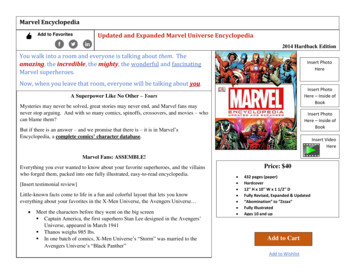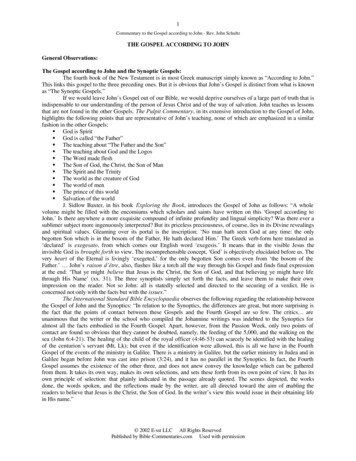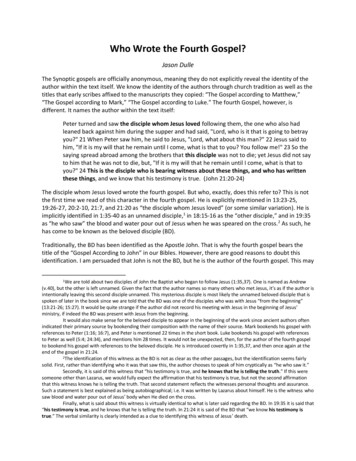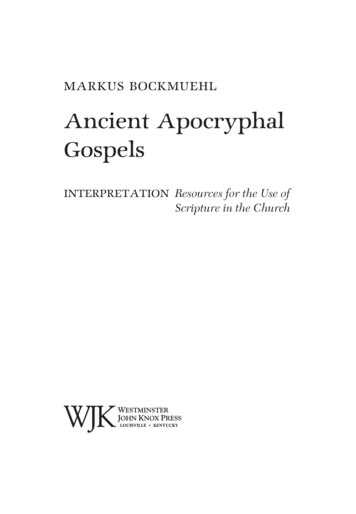
Transcription
CHRISTIAN RESEARCH INSTITUTEPO Box 8500, Charlotte, NC 28271Feature Article: JAF1383THE GOSPEL ACCORDING TO MARVELby John McAteerThis article first appeared in the CHRISTIAN RESEARCH JOURNAL, volume 38, number 03 (2015).For further information or to subscribe to the CHRISTIAN RESEARCH JOURNAL, go /.SYNOPSISOver the past decade, there has been a revival of interest in comic book superheroes,driven in large part by the Disney-owned Marvel Comics brand, publishers of suchcharacters as Spider-Man, the X-Men, the Avengers, and more. Every culture has had itsown heroes, from Hercules to King Arthur to the Lone Ranger, but the phenomenalpopularity of Marvel superheroes in recent years suggests that Marvel’s uniqueapproach to envisioning heroism is, for better or worse, feeding some sort of spiritualhunger in American culture. In the 1960s, Marvel transformed the entire comic bookindustry by introducing heroes who were ordinary people that found themselves withunique abilities and struggled to overcome personal weaknesses to use those abilitiesfor the benefit of those in need. Marvel’s attempt to ground their heroes in a morerealistic world than other superheroes led to at least two questionable results. First, theMarvel universe tends to avoid genuinely supernatural phenomena, instead explainingunusual events in science fiction terms. Second, as popular culture has coarsened in thedecades since the 1960s, Marvel’s flawed heroes have had to become more violent tomaintain their apparent psychological realism. This means that comic books are nowless appropriate for children than they were in the past. On the other hand, the positiveresult of Marvel’s emphasis on ordinary, realistic people is that readers can identifywith their flawed characters more easily than they could identify with the idealizedheroes of yesteryear. This means that Marvel fans can imagine themselves as potentialCRI Web: www.equip.orgTel: 704.887.8200Fax:704.887.8299
superheroes and learn to cultivate heroism in their own lives. Moreover, comic bookstories give us a clear sense of good and evil and the human need for a Savior who ismore than human, themes that Christian apologists can use to draw out the innateexistential longing for Christ hidden in the heart of all people.Superheroes are big business these days. Beyond the obvious comic books, TV series,movies, video games, and toys, superheroes now adorn everything from pajamas andlunchboxes to cell phone covers and ice cube trays. Superheroes are not just for kidsanymore, either. Adults can find neckties, shot glasses, and kitchen aprons. Pretty muchanything you can imagine can be found with superheroes printed on it. Scholars havelong traced a tradition of mythological heroes that runs from Hercules and Odysseus toRobin Hood and King Arthur to the Lone Ranger and Luke Skywalker. On this view,costumed crime fighters are only the most recent expression of a need for heroes foundin every culture.1 Superheroes, for better or worse, are clearly feeding some sort ofspiritual hunger in American culture.Riding highest on the current superhero wave we find Marvel Comics. Forexample, the 2012 movie Marvel’s The Avengers is at present the third highest-grossingfilm of all time and holds the box-office record for the biggest opening weekend of alltime, no doubt in part due to Marvel’s acquisition by the Walt Disney Company in 2009,which put the world’s greatest marketing and merchandising machine behind theMarvel brand.Marvel Comics is one of the two biggest comic book publishers, along with itsrival DC Comics. While DC is home of some of the most enduring and iconicsuperheroes—such as Superman, Batman, and Wonder Woman—Marvel Comics ownsthe hottest characters in popular culture right now, including Spider-Man, theIncredible Hulk, Captain America, Iron Man, The Fantastic Four, and the X-Men. Tounderstand the theological significance of Marvel’s ascendance, we must firstunderstand what distinguishes Marvel from DC.MARVEL’S “ORIGIN STORY”The Marvel Comics brand as we know it came into its own in 1961 with the publicationof The Fantastic Four, created by writer Stan Lee and artist Jack Kirby. As a product ofthe ‘60s, Marvel is a “Silver Age” phenomenon. Historians typically divide the historyof comics into three or more time periods.2 The Golden Age of comic books began inCRI Web: www.equip.orgTel: 704.887.82002Fax:704.887.8299
1938 with the first appearance of Superman. There had been costumed crime fighters inpop culture before, but Superman was the first comic book hero possessed of trulysuperhuman powers, and his extraordinary popularity sparked an industry ofimitators. The fashionability of superheroes gradually declined throughout the ‘40s and‘50s until DC revived the genre with the character of The Flash in 1956, which mosthistorians mark as the start of the Silver Age of comics. But it wasn’t until 1961 that thecomics world turned toward something truly new.With characters such as The Fantastic Four and Spider-Man, Lee and Kirby,along with their other colleagues at Marvel such as Steve Ditko, began taking a morerealistic approach to superheroes than ever before. They tried to create complexcharacters who grew and changed over time in ongoing stories. And they set theirstories in the real world—most often in New York City—rather than in fictional citiessuch as Gotham and Metropolis. By the time Jack Kirby left Marvel in 1970 to work forDC and Stan Lee was promoted from editor to publisher of Marvel in 1972, the two menhad changed comics forever. They had created a whole new kind of superhero.MARVEL VS. DC: TWO VIEWS OF HEROISMThe biggest difference between Marvel and DC is that Marvel heroes are ordinarypeople disguised as superheroes. Whereas DC’s Superman is really an alien (Kal-El)disguised as an average guy (Clark Kent), Marvel’s Spider-Man is just an ordinaryteenager named Peter Parker dressed up in red Spandex. Even DC’s Batman is using thepersona of millionaire playboy Bruce Wayne to distract from his true identity as avigilante hero. Bruce Wayne’s drinking and womanizing is all an act. Contrast Marvel’sIron Man whose true identity is Tony Stark, a millionaire playboy who really is asobnoxious as Brue Wayne pretends to be.Marvel heroes are complex characters with all the imperfections of real-lifehuman beings. They’re not all that “heroic” in comparison to a Golden Age DCcharacter such as Superman, who came to embody a kind of idealized moral perfection.The original DC heroes are mostly aliens (such as Superman and Wonder Woman) orself-made men (such as Batman). Marvel’s heroes, on the other hand, are flawedordinary people who gain unusual powers. They have extraordinary abilities thrustupon them whether they like it or not, usually through accidental exposure to“radiation” of some sort or another.Furthermore, Marvel heroes always have other real-life problems to deal with inaddition to fighting crime. For example, The Fantastic Four often argue amongthemselves like a dysfunctional family. Some Marvel characters—notably Fantastic Fourmember The Thing and the Incredible Hulk—are closer to monsters than typical heroesCRI Web: www.equip.orgTel: 704.887.82003Fax:704.887.8299
and consider their power a curse. The Hulk was explicitly modeled on Frankenstein’smonster, and like that poor creature, Marvel heroes are usually misunderstood bysociety. They’re outcasts, often wrongly hunted as criminals. Spider-Man worries aboutpaying the bills and dealing with his Aunt May’s health problems. In fact, many of theMarvel heroes have health problems of their own and other bodily frailties it would behard to imagine DC heroes having. The X-Men’s Professor Xavier is a paraplegicconfined to a wheelchair; Iron Man’s Tony Stark has a heart condition; Daredevil isblind; the original Silver Age version of Thor was the alter ego of a crippled humanmedical doctor who walked with a cane.In short, the Marvel idea of heroism is an ordinary person who finds him- or herselfwith unique abilities and struggles to overcome personal weaknesses to use those abilities to bebetter than they thought they could be. According to Marvel, a hero is someone who sharesSpider-Man’s motto: “With great power comes great responsibility.” Deep down, theymay not feel all that heroic, and they may feel like their power is more a curse than agift, but they’re doing the best they can to use their power for good. This is not far offfrom the Bible’s vision of heroism. One need not be a billionaire or a super-humanbeing from another planet to be a hero. God works through the foolish and the weak,not only the noble-born and powerful (1 Cor. 1:26–31).MYTHS AND FANTASYComic books function as myths—stories that interpret reality and our place in theworld.3 In fact, this is part of their appeal to artists. As comic book writer (and Marvel’sexecutive vice president in charge of television production) Jeph Loeb explains, writingwith the help of Christian philosopher Tom Morris, “The stories of these charactersembody our deepest hopes and fears, as well as our highest aspirations, and.they canhelp us deal with our worst nightmares.”4But whereas DC comics function primarily as wish fulfillment (e.g., we want totranscend human limitations like Superman5), Marvel’s flawed and realistic heroesenable us to see the potential in ourselves actually to be heroic in real life. They show ushow an ordinary geeky teenager can take responsibility for his gifts and use them tofight for justice. As writer David Zimmerman puts it, comic books can “open our eyesas witnesses to the heroism of God,” allowing us to “see the capacity for heroic actionthat He extends to us, and we realize that in spite of all we have suffered and all wehave done, by the grace of God we could be heroes.”6In this way, superhero stories help us see the real world in a new way, just asChristian writer J. R. R. Tolkien said fairy tales do. For Tolkien, fantasy stories are notjust entertainment for children. Fantasy serves the important purpose of “recovery” ofCRI Web: www.equip.orgTel: 704.887.82004Fax:704.887.8299
the real world—the “return and renewal of health,” a “regaining of a clear view” ofreality.7 By taking an imaginative holiday to a world that is obviously quite differentthan our own, we are able to see our own ordinary world afresh. Fantasy allows us to“be freed from the drab blur of triteness or familiarity” and to see “things as we are (orwere) meant to see them.” In short, fantasy redeems our vision, and allows us to“escape” from the “prison” in which our fallen imagination has locked itself.8Imaginative fiction, whether fairy tales or superhero comic books, teaches us to see“beyond the walls of the world” as it is now9 and to imagine and desire a better worldredeemed by Christ (Rom. 8:18–24).Superhero stories in particular help us see our own role in helping to bring aboutthat better world. Having experienced Marvel’s universe where ordinary people gainpowers that bring with them responsibility to do good, we may be awoken to the factthat, in the real world, each of us has our own kind of power and therefore our ownresponsibility (1 Pet. 4:10). Most of us are not wealthy or politically influential, buteveryone has power over something, even if it is only his or her own choices. And ourcalling in Christ is to use what power we have to bring God’s love to the suffering (Eph.2:10) so that they will glorify God (Matt. 5:16).Moreover, superhero stories help us understand ourselves as strangers and exiles(1 Pet. 2:11) who are in the world but not of it (John 17:14–15). Superheroes look normalbut have a secret that would cause people to hate them. They want to be ordinaryAmericans but feel like outsiders—much like the Jewish immigrants who created thesecharacters.10 Christians can appropriate this idea. We, too, look normal to the world buthave a secret identity in Christ (Col. 3:3), and we are part of what Christian philosopherDallas Willard called God’s “Divine Conspiracy” to save the world (2 Cor. 5:18–20).THE MODERN AGE OF COMICSI don’t mean to give the impression that comic books are entirely positive. These days,comic books are more appropriate for adults than for children. Over the years, comics—like all of American popular culture—have gotten more violent and more sexuallyrisqué. In fact, this could be interpreted as an unintended consequence of Marvel’semphasis on moral complexity and psychological realism. As cultural attitudes changefor the worse, fictional characters must change for the worse to maintain their claim torealism.Historians trace the start of the Modern Age of Comics to 1986, kicked off by twographic novels, Frank Miller’s The Dark Knight Returns and Alan Moore’s Watchmen,which were darker in tone and focused more on adult themes than earlier comics. Thesestories assumed a familiarity with the superhero genre and were aimed at adults whoCRI Web: www.equip.orgTel: 704.887.82005Fax:704.887.8299
had grown up with comics. During this current historical period, mainstream comicshave been dominated by antiheroes, characters motivated by revenge and vigilanteswilling to kill in the name of justice. In the Marvel universe, this includes some of themost popular characters of the past thirty years such as Wolverine, The Punisher, GhostRider, Deadpool, and so on. Marvel has always been about moral complexity, but thesenew heroes don’t even try to avoid violence.For the most part, however, there is still the sense that a line exists betweenheroes and villains, though antiheroes blur that line and occasionally cross it. Overtime, characters in the Marvel universe change sides. A hero can become a villain orvice versa. Characters such as Hawkeye and Black Widow began as villains and laterjoined the Avengers as heroes. Conversely Jean Grey from the X-Men became a villainnamed the Dark Phoenix. Theologian Russ Dalton argues that this moral complexityallows Marvel to avoid the typical Manichaeism of comics. He defines Manichaeism as“seeing good and evil as two equal and competing forces struggling for control of theuniverse,” and explains that this is incompatible with Christianity. “Christians knowthat all have sinned and that no human is totally good. Likewise they know thateveryone is redeemable and no one is totally evil.”11NATURALIZED SUPERNATURALISMAnother downside of Marvel’s attempt to be more realistic than other comic bookuniverses is that Marvel tends to downplay the supernatural. While Marvel comicspurport to take place in our world (New York, not “Gotham City”), Marvel’s vision isnot entirely a Christian interpretation of our world. Instead, Marvel imagines a mostlynaturalistic world. There are “gods” in the Marvel universe such as Thor, but thesebeings are ultimately explained as aliens from other planets. There is also talk of sorceryand black magic, but sorcerers are usually also scientists (e.g., Dr. Doom and Dr.Strange), so the sorcery could be interpreted as science connecting to other dimensions.This is explicit in Marvel’s films such as Thor, The Avengers, and Guardians of theGalaxy. Marvel Studios president Kevin Feige says, “In the Marvel Cinematic Universeversion of the supernatural, that involves everything from quantum mechanics to stringtheory.” In other words, there are no real supernatural beings, and what we callsupernatural is simply natural phenomena that science doesn’t understand yet.Presumably this will be true even of the upcoming movie about the superheroDr. Strange, a former neuroscientist who turned to magic to battle evil spirits. Feigesays, “The idea of this film is to open up a whole new corner of the cinematic universe.We want to enter, through Strange, the world of parallel dimensions.”12 Again, the ideaseems to be that the “demons” Dr. Strange battles will be interpreted as natural beingsCRI Web: www.equip.orgTel: 704.887.82006Fax:704.887.8299
from other dimensions, rather than genuinely supernatural beings beyond the ability ofscience to explain. On the other hand, the film is being directed by Christian filmmakerScott Derrickson who has made two films (The Exorcism of Emily Rose and Deliver UsFrom Evil) inspired by true stories of demonic possession, so it remains to be seenwhether Derrickson will push for a genuinely supernatural interpretation of Dr.Strange’s world.In any case, while the Marvel universe seems to be committed to philosophicalnaturalism, it does not idolize science. Created in the context of 1960s anxieties aboutthe atomic age, Marvel’s scientist characters are just as likely to cause problems as tosolve them. This is a truth Christians can embrace. We know that only God is worthy tocontrol the world (Gen. 11:4–9). Human sin should make us suspicious of any attemptto gain unconstrained power, whether through politics, technology, or superhumanabilities. Unlike DC, which (at least in the Golden Age) tends to see power asunproblematic, Marvel makes sure we realize that power not only can be abused but itcan also wreak unintended consequences, since the world is ultimately beyond humanability to control. For Marvel, a radiation accident is just as likely to turn you into amonstrous Thing as into a Human Torch, just as likely to make you a Hulk ofuncontrollable rage as to give you the proportionate strength of a spider.ALTARS TO THE UNKNOWN HEROH. Michael Brewer argues that our longing for superheroes points toward a need for ahero that can only be fulfilled in Christ: “The spiritual hunger for heroes is woven intothe fabric of the human creature. Our Maker built us with a persistent longing for arescuer who will save us from injustice and suffering.”13 B. J. Oropeza develops this ideafurther. He argues that the standard superhero myth follows the contours of the biblicalnarrative of creation-fall- redemption-restoration. Oropeza points out that the “originstory” of most superheroes involves a tragic loss (often the death of the hero’s parents)that transforms them into a kind of messianic savior who must ultimately face theforces of evil in an “apocalyptic battle,” which frequently climaxes in the hero’s rebirthfrom an apparent death.14According to Oropeza,Most superheroes suffer tragic loss: Superman, Batman, Spider-Man, Robin, and Toro all losetheir parents, the Hulk loses his sanity, and Spawn his life. Yet despite their losses, or sometimesbecause of them, they gain a sense of great commission, forever trying to mend something thathas been torn apart. Their stories present a subtle parable to humanity: We have lost our trueCRI Web: www.equip.orgTel: 704.887.82007Fax:704.887.8299
identity and need to recover what has been taken from us. Apparently somewhere deep withinour psyche, we understand our status as fallen creatures.15This is essentially the same approach Paul took toward the false gods of Greekmythology (Acts 17:16–33). He saw both similarities and differences and argued that theGreek myths pointed toward the true God and hence were fulfilled in Christ. As C. S.Lewis said, the old myths had become true in Christ.16 Paul saw that the Greeks werereally looking for God all along (Acts 17:27) and that his job as an apologist was to nameChrist as the One in whom our deepest longings are fulfilled.The same strategy should apply to today’s myths: comic book superheroes. Ourculture has a sense that something is wrong with the world and that, despite our ownfailings, we have a responsibility to do something about it. We also know, if we arehonest with ourselves, that we have no power in ourselves to help ourselves (2 Cor.3:5). Christianity gives the best diagnosis of the problem and offers the only hope forsalvation. Only with the True Hero living in our hearts can we have the power toovercome the forces of sin and death (Rom. 8:31–39).John McAteer is assistant professor at Ashford University where he serves as the chairof the liberal arts program. Before receiving his PhD in philosophy from the Universityof California at Riverside, he earned a BA in film from Biola University and an MA inphilosophy of religion and ethics from Talbot School of Theology.NOTES123456Greg Garrett, Holy Superheroes! Exploring the Sacred in Comics, Graphic Novels and Film, rev. ed.(Louisville: Westminster John Knox Press, 2008), 9–16.A good brief history of comic books can be found in B. J. Oropeza’s “Superhero Myth and theRestoration of Paradise,” in The Gospel according to Superheroes: Religion and Popular Culture, ed. B. J.Oropeza (New York: Peter Lang, 2005), 10–18.Russell W. Dalton, Marvelous Myths: Marvel Superheroes and Everyday Faith (St. Louis: Chalice Press,2011), 1.Jeph Loeb and Tom Morris, “Heroes and Superheroes,” in Superheroes and Philosophy, ed. Tom Morrisand Matt Morris (Chicago: Open Court, 2005), 11.Ben Saunders, Do the Gods Wear Capes? Spirituality, Fantasy, and Superheroes (London: BloomsburyAcademic, 2013), 3.David A. Zimmerman, Comic Book Character: Unleashing the Hero in Us All (Downers Grove:CRI Web: www.equip.orgTel: 704.887.82008Fax:704.887.8299
78910111213141516InterVarsity Press, 2004), 142.J. R. R. Tolkien, “On Fairy-Stories,” in The Tolkien Reader (New York: Ballantine Books, 1966), 57.Ibid., 60.Ibid., 68.Many of the most important comic book creators of the Golden and Silver Age were Jewish. Theseinclude Joe Shuster and Jerome Siegel (creators of Superman), Bob Kane and Bill Finger (creators ofBatman), and Stan Lee and Jack Kirby (creators of the Fantastic Four, the Avengers, and manyothers).Dalton, 3.http://marvel.com/news/movies/23542/marvels doctor strange conjures up a november 2016 release date#ixzz3R5dvejDU.H. Michael Brewer, Who Needs a Superhero? Finding Virtue, Vice, and What’s Holy in the Comics (GrandRapids: Baker Books, 2004), 10.Oropeza, 6–10.Ibid., 6.C. S. Lewis, “Myth Became Fact,” in God in the Dock (Grand Rapids: Eerdmans, 1970), 54–60.CRI Web: www.equip.orgTel: 704.887.82009Fax:704.887.8299
The Marvel Comics brand as we know it came into its own in 1961 with the publication of The Fantastic Four, created by writer Stan Lee and artist Jack Kirby. As a product of the 60s, Marvel is a Silver Age phenomenon. Historians typically divide the history of comics into three or more time periods.2 The Golden Age of comic books began in










